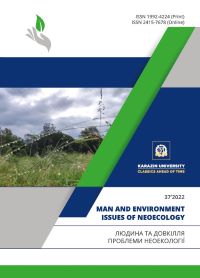Water facilities of Ternopil: hydrography, ecological condition and water supply
Abstract
Results. Generalization and systematization of data on the hydrographic network of the Ternopil city, allows us to state the fact that the main water bodies of the city is the Seret River – 242 km long (within the city 1.8 km) and the basin area 3900 km2; reservoir – an area of 300 hectares, nameless right tributary and canalized left tributary of the Seret River – the Rudka. The ecological condition of the Seret River within the city of Ternopil can be assessed as unsatisfactory. The main geoecological problems of the river are construction within the the coastal protection zone, water pollution by solid waste, exceeding the maximum allowable concentrations of suspended solids, sulfates, chlorides, nitrates and petroleum products. Environmental problems of the Ternopil reservoir are water pollution by chemical compounds of ammonium nitrogen, petroleum products, suspended solids and total iron; high siltation and pollution of the bottom sediments of the reservoir with heavy metals and mobile forms of biogenic elements. Water supply in the Ternopi cityl is carried out from two water intakes - Biletsky and Verkhnyo-Ivachivsky. Verkhno-Ivachivsky water intake is located at a distance of 3 km from the city landfill in the village of Malashivtsi. In the last few years, the process of drilling and using private artesian wells with a depth of more than 50 m has become widespread in the city. According to the results of the analysis, installed compliance with sanitary requirements of water samples in these wells, pH in all samples within normal limits (6,5-8,5).
Conclusions. Current trends in climate change and the growth of anthropogenic pressure on water bodies, increases the risks of degradation and changes in some components of the hydrographic network of the city. In Ternopil, it is necessary to modernize the centralized water supply system, reconstruct rainwater collectors and strengthen control over unauthorized discharges into surface water bodies. It is also worth designing another water intake for the city in environmentally secure conditions.
Downloads
Published
Issue
Section
License
Copyright (c) 2022 Царик Л. П., Кузик І. Р., Янковська Л. В.

This work is licensed under a Creative Commons Attribution 4.0 International License.
Автори, які публікуються у цьому журналі, погоджуються з наступними умовами:- Автори залишають за собою право на авторство своєї роботи та передають журналу право першої публікації цієї роботи на умовах ліцензії Creative Commons Attribution License, котра дозволяє іншим особам вільно розповсюджувати опубліковану роботу з обов'язковим посиланням на авторів оригінальної роботи та першу публікацію роботи у цьому журналі.
- Автори мають право укладати самостійні додаткові угоди щодо неексклюзивного розповсюдження роботи у тому вигляді, в якому вона була опублікована цим журналом (наприклад, розміщувати роботу в електронному сховищі установи або публікувати у складі монографії), за умови збереження посилання на першу публікацію роботи у цьому журналі.
- Політика журналу дозволяє і заохочує розміщення авторами в мережі Інтернет (наприклад, у сховищах установ або на особистих веб-сайтах) рукопису роботи, як до подання цього рукопису до редакції, так і під час його редакційного опрацювання, оскільки це сприяє виникненню продуктивної наукової дискусії та позитивно позначається на оперативності та динаміці цитування опублікованої роботи (див. The Effect of Open Access).

